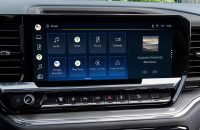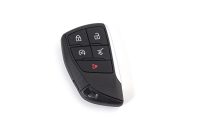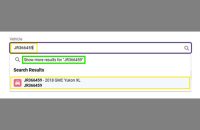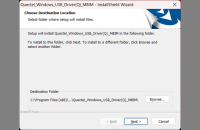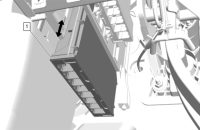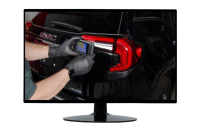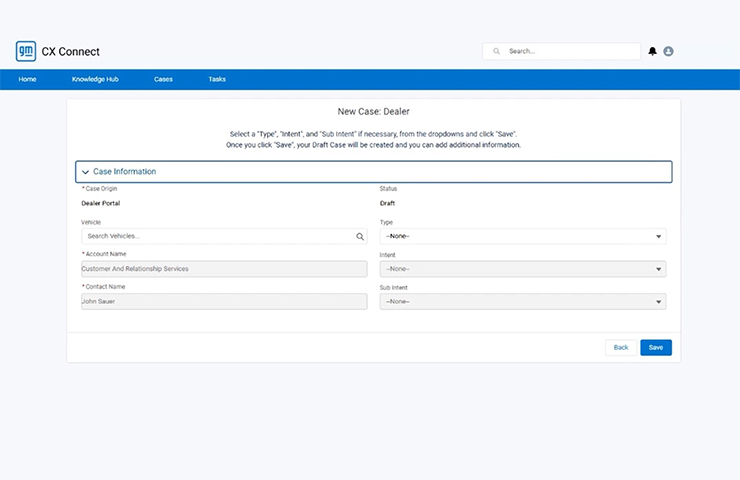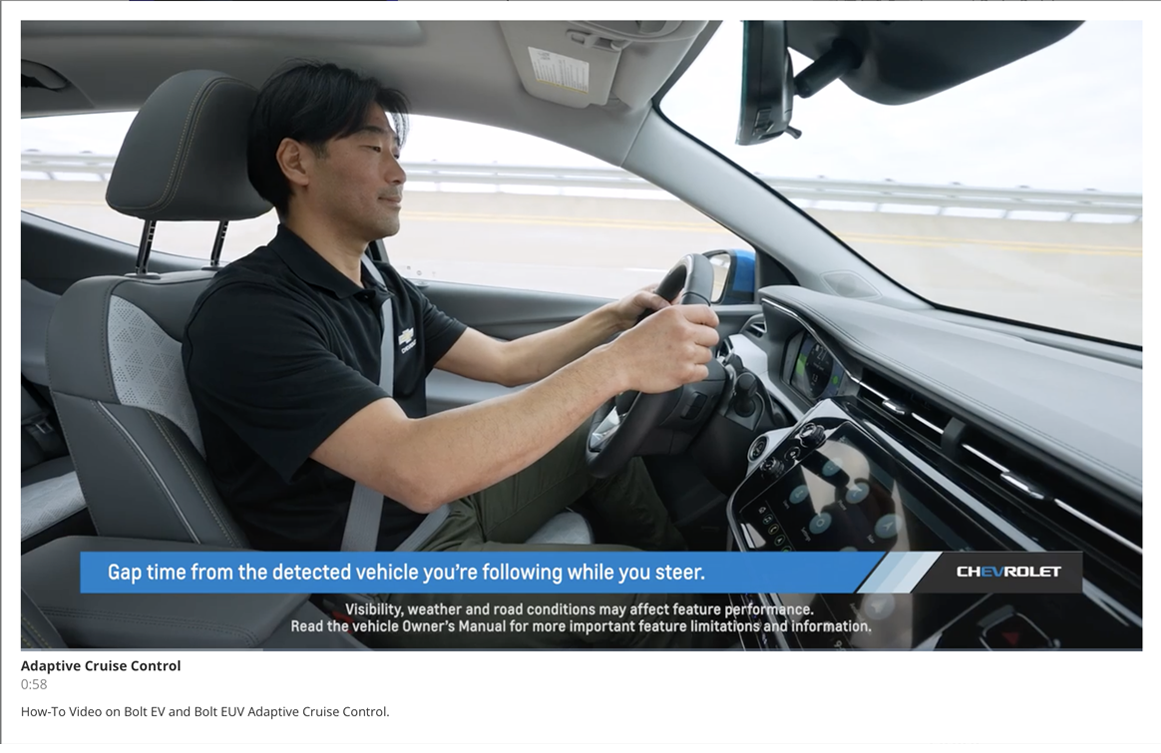The all-new 2025 OPTIQ is the latest entry in Cadillac’s EV lineup. (Fig. 3) It will launch with several segment-leading features that add to its performance, style and functionality.
 Fig. 3
Fig. 3
Built on a 6-inch shorter wheelbase than the LYRIQ, the OPTIQ features the revolutionary Ultium Platform, standard dual-motor all-wheel drive, and a near 50/50 weight distribution — all contributing to an agile architecture that delivers an athletic driving experience. The 85-kilowatt-hour high-voltage battery pack offers a Cadillac-estimated 300 horsepower and 354 lb.-ft. of instant torque. And with exceptional aerodynamic performance, the OPTIQ has a Cadillac-estimated 300-mile driving range on a full charge. 150 kW public DC Fast Charging can add up to 79 miles of range in about 10 minutes.
Note: Actual range may vary based on several factors, including ambient temperature and terrain. Actual charge times will vary based on battery starting state of charge, battery condition, output of charger, vehicle settings and battery temperature.
Standard safety and driver assistance technologies include Adaptive Cruise Control, Blind Zone Steering Assist, Enhanced Automatic Parking, Forward Collision Alert and several others. Plus, Super Cruise driver assistance technology is standard.
Note: Safety or driver assistance features are not a substitute for the driver’s responsibility to operate the vehicle in a safe manner. The driver should remain attentive to traffic, surroundings and road conditions at all times. Visibility, weather and road conditions may affect feature performance. Always pay attention while driving and when using Super Cruise. Do not use a hand-held device. Requires active Super Cruise Plan or trial.
The upscale cabin features a 33-inch diagonal advanced LED display with 9k resolution projecting over one billion colors and Google built-in compatibility, featuring Google Maps and Google Assistant. (Fig. 4)
Note: Google built-in services are subject to limitations and availability may vary by vehicle, infotainment system and location. Select service plan required.
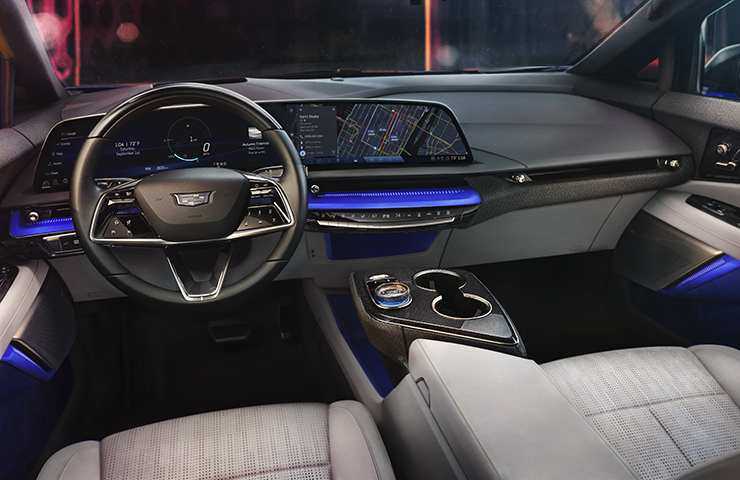 Fig. 4
Fig. 4
Exterior Design
Unique exterior design details on the OPTIQ are noticeable right away when approaching the vehicle. Signature lighting choreography at the front and rear of the vehicle displays when the driver approaches or exits the vehicle with the key fob. (Fig. 5)
 Fig. 5
Fig. 5
Classic Cadillac styling is continued on the OPTIQ’s rear quarter panel window design that showcases a Cadillac-first precision pattern in acoustic laminate glass. (Fig. 6) The graphic pattern is found throughout OPTIQ and aligns with the Mondrian crest. The OPTIQ also features a fixed-glass roof with a seamless transition from glass to sheet metal.
 Fig. 6
Fig. 6
At the rear of the vehicle, the Autosense hands-free power liftgate offers added convenience by opening automatically after approximately 5 seconds when the key fob is within 3 feet of the rear of the vehicle. A series of warning chirps sound before the liftgate opens. To cancel an automatic opening, move the key fob more than 3 feet away from the vehicle.
To open the power liftgate manually, press the lower part of the Cadillac Crest on the liftgate.
Powered by Ultium
The high-voltage A4 Hybrid/EV Battery Pack consists of lithium-ion cells. (Fig. 7) Several cells are welded together in series or parallel to form the Cell Module Assembly (CMA), or high-voltage section battery. Based upon option content, the battery pack may contain up to 12 CMAs. The total voltage of the 12 CMAs combined is about 400V. The high-voltage battery pack is installed from beneath the vehicle.
 Fig. 7
Fig. 7
The K16 Battery Energy Control Module (BECM) controls and monitors battery pack operation and is the host controller for all battery diagnostics and system status. The BECM is located outside of the battery pack assembly within the passenger compartment right-side floorboard beneath the carpet.
Up front, the electric-drive transmission is a fully automatic, front-wheel-drive transaxle that consists primarily of an 180kW drive motor, one differential/offset gear set, a mechanical transmission fluid pump and housing, and two axles.
At the rear, the electric-drive transmission is a fully automatic, rear-wheel-drive transaxle (Fig. 8) that includes a 67kw drive motor, one differential/offset gear set, and two axles.
 Fig. 8
Fig. 8
TIP: The option content of the vehicle will depend on how many Drive Units, Drive Motor Control Modules, Battery Energy Control Modules, Battery Chargers and Drive Unit Oil Coolers are equipped on the vehicle.
The K107 Drive Motor Control Module 1 is integrated into the T18 Battery Charger. (Fig. 9) Depending on the option content of the vehicle, the K107B Drive Motor Control Module 2 and the K107C Drive Motor Control Module 3 also may be integrated into the T18 Battery Charger.
 Fig. 9
Fig. 9
For added range, regenerative braking with Regen on Demand and One-Pedal Driving can be used to help conserve and capture braking energy. Enable and customize the One-Pedal Driving features by selecting Controls > Drive & Park > One-Pedal Driving on the infotainment screen.
To activate additional regenerative braking, pull and hold the Regen on Demand paddle on the left side of the steering wheel. (Fig. 10) While pulling the paddle, the vehicle will decelerate using regenerative braking. The paddle is pressure-sensitive, and the vehicle will slow more as the paddle is pulled. Regen on Demand is deactivated once the paddle is released.
Note: One-Pedal Driving and Regenerative braking may be limited under certain conditions, including when the high-voltage battery is near full charge or cold.
 Fig. 10
Fig. 10
Hands-Free Start
The vehicle is equipped with Hands-Free Start, which will automatically start the vehicle with the key fob in the passenger cabin.
To enter the passenger cabin, with the key fob within range, press the front of the door handle to deploy it and then pull the handle to open the door. The door handles also can be programmed to deploy automatically by going to Settings > Vehicle > Remote Lock, Unlock and Start > Remote Door Unlock.
To start the vehicle, with the key fob in the vehicle, press the brake pedal or close the driver’s door. The vehicle will power on automatically and the Ready icon will appear on the cluster display when the vehicle is ready to be driven. If a key fob was left in the vehicle after the last power cycle, the brake pedal must be applied to power on the vehicle.
After driving the vehicle, it will power off automatically once the vehicle is shifted into Park, the vehicle is exited and the driver’s door is closed. To turn off the vehicle manually, with the vehicle in Park, select the Off icon on the infotainment screen. If the vehicle was powered on, but never shifted out of Park, the vehicle must be turned off manually.
To keep the vehicle on after exiting the vehicle, shift to Park and then select the Extend Mode icon on the infotainment screen. The vehicle will remain on for a set time displayed on the infotainment screen.
Advanced LED Display
The OPTIQ does not feature a traditional instrument cluster to display vehicle information to the driver. Instead, it uses the A105 Instrument Panel Multifunction Human-Machine Interface Control Module, which is a multifunction module that provides a variety of vehicle information. The 33-inch diagonal display is highly reconfigurable and certain areas of the display can be accessed as a touchscreen. (Fig. 11)
 Fig. 11
Fig. 11
The A105 Instrument Panel Multifunction Human-Machine Interface Control Module is not on the vehicle serial data bus and, therefore, does not directly report or store DTCs. Instead, it is directly connected to the A11 Radio via an LVDS cable and relies on the A11 Radio for any information about vehicle status.
The infotainment system comes with Google built-in compatibility, which features Google Maps, Google Assistant and Google Play. To access an item, users can touch an application icon on the infotainment touchscreen or use the rotary infotainment controller and buttons on the center console.
Active Safety System
The active safety system includes a comprehensive feature set designed to help a driver avoid collisions or reduce crash damage while driving, backing and parking. The K124 Image Processing Module is the primary controller for the active safety system. The Image Processing Module communicates on multiple serial data busses to share information with various control modules throughout the vehicle and uses various sensors and control modules to monitor the vehicle’s surroundings in order to take deliberate action to avoid collisions or reduce crash damage. The active safety system tightly integrates the Forward Collision Alert, Adaptive Cruise Control, Parking Assist, and Active Emergency Braking Systems into a single, cohesive system.
The K124 Image Processing Module communicates via serial data on CAN 8 with the B174W Front View Camera – Windshield, B233B Forward Range Radar Sensor – Long Range, B233LF Short Range Radar Sensor – Left Front, and B233RF Short Range Radar Sensor – Right Front to create a virtual fusion image of the area in front of the vehicle.
At the rear of the vehicle, the K124 Image Processing Module uses the B233LR Short Range Radar Sensor – Left Rear, B233RR Short Range Radar Sensor – Right Rear, B233SL Short Range Radar Sensor – Left Rear Side, B233SR Short Range Radar Sensor – Right Rear Side, and the K182 Parking Assist Control Module as part of the backing warning system and the Rear Automatic Braking System.
Standard safety and driver assistance systems include:
- Blind Zone Steering Assist
- Lane Keep Assist with Lane Departure Warning
- Enhanced Automatic Emergency Braking
- Intersection Automatic Emergency Braking
- Rear Cross Traffic Braking
- Front Pedestrian and Bicyclist Braking
- Reverse Automatic Braking
- Forward Collision Alert
- Side Bicyclist Alert
- Safety Alert Seat
- Rear Pedestrian Alert
- Rear Cross Traffic Alert
- Front and Rear Park Assist
- Enhanced Automatic Parking Assist
Many of these features can be turned on/off or the settings can be adjusted using the infotainment screen. Go to Settings > Vehicle > Collision/Detection Systems.
Charging Features
The dual-level charge cord provided with the vehicle features a standard 120V receptacle for level 1 charging and a 220–240V receptacle for level 2 charging. (Fig. 12)
 Fig. 12
Fig. 12
Level 1 and level 2 AC charge current is converted by the on-vehicle T18 Battery Charger Module and the K57B Battery Charger Control Module 2 to direct current (DC) to charge the hybrid/EV battery pack.
A level 3 off-vehicle direct current (DC) fast charge drive motor battery charger allows charging using DC current supplied directly to the drive motor battery. DC Fast Charging, available at certain public charging stations, provides quick charging of the vehicle’s battery while traveling away from home. DC Fast Charging works best to quickly add miles of range to your vehicle when its charge is below 80%.
The status of charging events is communicated to the user through visual indications and audio tones, including the vehicle charge status indicator located on the top of the instrument panel.
The charging app on the infotainment screen provides details about the vehicle’s energy use as well as the ability to customize the charging settings for several features, including delayed charging, charge levels, home charge location and others.
For more information about the 2025 OPTIQ, refer to Bulletin #24-NA-266.
– Thanks to Kristin Clancy




